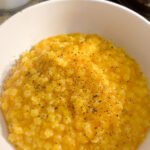Easy Pastina
AKA Italian Penicillin - this Pastina is the definition of Italian comfort food. It's cozy, comforting, so easy to make and comes together with minimal ingredients.
Servings: 4 servings
Calories: 368kcal
Equipment
- 1 immersion blender or stand blender
Ingredients
- 4 cups water
- 4 cups chicken or vegetable stock (or more water)
- 1 large yellow onion
- 1 head garlic
- 3 large carrots
- 3 celery stalks
- 2 dried bay leaves
- 1 Parmesan rind, optional (but highly recommended; see Note 1)
- 2 tsp salt, divided, or more to taste
- 1-2 tbsp butter, optional (see Note 2 & 5)
- 227 grams pastina of choice (about 1 ¼ cups; see Note 3)
- 2 tbsp Parmesan cheese, grated
- Freshly ground black pepper, to taste
- For Serving (Optional)
- Parmesan cheese, grated
- Freshly cracked black pepper
- Lemon juice
- Extra virgin olive oil
Instructions
- Peel the vegetables; quarter the onion, roughly chop the celery and carrots and slice off the top of the head of garlic (or wash well and leave the peels on)
- In a large pot, combine water, stock, vegetables, garlic, bay leaves and Parmesan rind
- Season with 1 tsp salt and bring to a boil, then reduce to a simmer and cover with a lid
- Allow to simmer for 30-40 minutes until the vegetables are soft and the carrots can be easily pierced with a fork; remove the Parmesan rind
- Blend the vegetables using either an immersion blender directly in the pot or by transferring the vegetables and 1-2 cups of liquid to a stand blender, then returning the mixture to the pot
- Leave the pureed vegetable broth over low heat so it stays warm
- In a medium saucepan, melt 1 tbsp of butter and toast the pastina for 2-3 minutes (see Note 2)
- Pour in enough of the warm broth to cover the pastina and the remaining tsp of salt
- Bring to a low boil; keep stirring so it doesn't stick to the bottom of the pot
- Add a ladle of broth at a time and continue cooking until the desired consistency is reached and the pastina is al dente (about 2-3 cups of broth; see Note 4)
- Add the Parmesan cheese and freshly cracked black pepper and stir, then taste and season with additional salt if needed
- Stir in the remaining tbsp of butter (see Note 5)
- Serve topped with additional Parmesan cheese, freshly cracked black pepper, lemon juice or extra virgin olive oil if desired
Notes
1. Parmesan rinds add an amazing salty and umami flavor to sauces and broths. I like to cut the rinds off my Parmesan wedges and freeze them to use in recipes. If you don't have one, you can leave it out.
2. Toasting the pastina enhances the overall flavor, but it's a totally optional step. If you prefer to leave out the butter, just skip this step.
3. Pastina just means "little pasta." Multiple pasta shapes are considered pastina, so use whatever you prefer or whatever you can find. Some of the most easy to find shapes are stelline (little stars), acini di pepe, ditalini or orzo. Little shells (conchigliette) or rings (anelletti) or even alphabets are also great options!
4. The total cooking time will depend on the pasta shape used, but most pastina noodles cook in no more than 10 minutes. As for the texture, that's completely up to your preference. I love my pastina with just a little extra broth, but you can make it very brothy, like a soup, or on the thicker side, like a risotto.
5. A little butter stirred in at the end of the cooking adds a little touch of richness and creaminess to the final dish. Again, it's totally optional, so you can leave it out if you prefer!
Nutrition
Serving: 1 serving | Calories: 368kcal | Carbohydrates: 60g | Protein: 16g | Fat: 8g | Saturated Fat: 3g | Polyunsaturated Fat: 1g | Monounsaturated Fat: 2g | Trans Fat: 0.1g | Cholesterol: 17mg | Sodium: 1654mg | Potassium: 492mg | Fiber: 4g | Sugar: 9g | Vitamin A: 7777IU | Vitamin C: 8mg | Calcium: 82mg | Iron: 3mg
